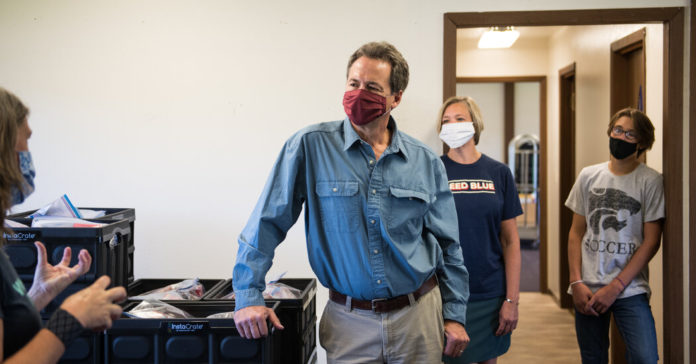BOZEMAN, Mont. — In the deeply polarized election of 2016, every state that supported President Trump backed Republican senators — and each state that Hillary Clinton carried voted for a Democratic Senate candidate.
But four years later, Democratic hopes for gaining a clear Senate majority depend in part on winning in conservative-leaning states where Mr. Trump may also prevail, even as he sags in the polls. In states like Alaska, Iowa, Georgia and here in Montana, Democrats are hoping their Senate candidates can outperform Joseph R. Biden Jr., their presumptive nominee.
That’s the dynamic Gov. Steve Bullock is counting on in Montana, where ticket-splitting is as much a way of life as fly-fishing.
Montanans have supported Republican presidential candidates, with one exception, for over a half-century. In that same period, though, they have elected a series of Democratic governors and senators. Senator Steve Daines, whom Mr. Bullock is challenging, was the first Republican elected to the Senate seat that he holds in over a century.
Yet as he faces off against Mr. Bullock, whose popularity has risen as he leads the state’s coronavirus response, Mr. Daines is counting on Montanans to act a little more like voters everywhere else and stick with one party as they make their way down the ballot.
The race here will measure the political impact of the pandemic — many governors have grown in stature for their handling of the virus, and Mr. Bullock is the only sitting governor running for the Senate. It will also test Montana’s iconoclastic identity in a time of encroaching red-and-blue homogeneity.
But for Democrats, going on the offensive in a red-leaning state in an age of polarization is no easy task. By nominating the more moderate Mr. Biden, they hope they can at least lose more closely, if not win outright, in states where Mrs. Clinton was thrashed and her party’s Senate candidates went down with her.
“The reason he was so strong in ’16 is because you could go up and down here — Democrats and Republicans would both tell you they hate Hillary,” Jon Tester, a Democrat who is Montana’s senior senator, said of Mr. Trump over an afternoon beer in Great Falls.
Even as Mrs. Clinton lost Montana overwhelmingly, though, Mr. Bullock still managed to get re-elected as governor.
A Helena-reared lawyer who made a foray for president last year, Mr. Bullock has won statewide office three times, first as attorney general before he became governor.
“Montanans know me,” he said in an interview, explaining how he’d overcome Republican claims that he’d abet liberal voices in Washington. “I’ve worked with Republicans to get things done.”
Winning a federal race, in which the issues are more national in scope, is difficult enough for a Democrat in a red state. But Mr. Bullock made that task harder by leaving Montana for half of 2019 to run for president, drifting to the left on some issues and repeatedly insisting he would not fall back to seek the Senate seat.
Without prompting last week, though, he noted that he had stood up to President Barack Obama’s administration on environmental policies he thought were harmful to Montana’s agriculture and energy sectors.
Such talk was notably absent from his White House bid, when he sought the Democratic nomination by edging to the left on gun control and deeming Mr. Trump a “lying con man from New York with orange hair and a golden toilet.”
Asked if his ridicule of Mr. Trump was over the line, he suggested some regret.
“By Washington standards, not at all,” Mr. Bullock explained. “By my typical standards, stronger than things that I would typically say.”
Navigating Mr. Trump is a delicate issue for Montana Democrats, who must energize their liberal base without alienating the state’s ticket-splitters. Mr. Tester aired ads in his 2018 re-election campaign trumpeting his work with the president, which helped blunt the impact of Mr. Trump’s four trips to the state that year.
Few G.O.P. senators have so happily linked themselves to Mr. Trump as Mr. Daines, a chemical engineer by training who represented Montana as its lone congressman before winning his Senate seat in 2014.
In an interview in his Bozeman campaign office, he said he was eager for the president to return to the state and revealed that Mr. Trump had “asked to come, too.”
However, just as Mr. Bullock’s ill-fated bid for president has complicated his attempt to run again in Montana, the coronavirus has created headwinds for Mr. Daines.
Mr. Trump’s standing here has fallen, as it has elsewhere, because of his ineffective response to the outbreak. Some Republican polling this summer suggests he is leading Mr. Biden only by single digits in Montana.
Asked to assess the president’s performance on the pandemic, Mr. Daines largely sidestepped the question, stating that he supported letting states and localities “have primacy.”
Further muddling matters for Mr. Daines: Any effort by him to embrace the national Republican strategy of pinning the blame on China for the virus’s spread in America is complicated by his years of work for Procter & Gamble in China. Democrats are already airing commercials highlighting the senator’s work in the country.
More than anything, though, the health crisis has created challenges for Mr. Daines by delaying the parry-and-thrust of the campaign, allowing Mr. Bullock to enjoy what his opponent called a “rally around the flag” bounce.
Mr. Daines acknowledged that his role was more of constituent service specialist than candidate — and that the virus was foremost on the minds of voters.
“These are third-generation business owners that are crying on the phone to me, saying: ‘Steve, I’m losing everything,’” he recalled. “And so in that moment you’re not thinking so much about, ‘Well, Steve Bullock got an F on guns and I got an A+.’ It’s not the discussion.”
That was easy enough to see as the two officials made their way across this sprawling state, where the metric for a candidate’s sweat equity is in tires changed, not shoes replaced.
In the Flathead region, near Glacier National Park, Mr. Bullock visited a food bank. As he toured a nearby timber facility, the governor was joined by an employee, a Trump voter now dejected by the country’s state of affairs, whose stepmother had contracted the virus.
Closer to Great Falls, Mr. Daines was similarly confronted with fallout from the pandemic.
He visited a small agricultural equipment dealer who thanked him for the paycheck protection loan that he had received through Congress. “It was a big help,” said the dealer, Steven Raska, explaining that he had been able to pay a few employees for over two months with the money.
Demonstrating his clout with the Trump administration, Mr. Daines also convened a round-table event for ranchers and farmers that featured Bill Northey, a top administrator at the Department of Agriculture. The growers gave both men an earful about how the virus had upended their livelihoods.
“Covid could not have hit the sheep industry at a worse time,” said Leah Johnson, who runs the Montana Wool Growers Association.
With the virus spiking in the state, Mr. Bullock finally issued a mask mandate on July 15 for any county with four or more active cases.
Former Senator Max Baucus, a Democrat who represented the state in Congress for nearly 40 years, said the pandemic had initially lifted Mr. Bullock.
“But the trouble with Covid is you can’t get out and shake hands, and that would help him compare himself to Daines,” said Mr. Baucus, explaining that he had overcome Montana’s national Republican leaning by cultivating individual voters. “My main approach to the state was: people, people, people.”
The uncertainty surrounding the virus, and Montana’s heterodox political nature, were on display Thursday in Bozeman. A few dozen protesters in Trump gear hoisted signs and marched down the city’s commercial center in opposition to the mask order.
They passed a number of storefronts that even before the mandate had asked customers to wear masks — a reflection of the changing nature of Bozeman. There’s now a Lululemon, sitting across the street from a coffee shop plastered with anti-racism signs that could have been pulled from the most liberal college campus (“De-Prioritize White Comfort”).
Few places have as strong a sense of place as Montana, where politicians routinely invoke how many generations their families go back in the state. This focus on rootedness and the state’s sparse population have helped perpetuate its independent streak as races remain more about the individual.
“We have six people per square mile and three times as many cows as people, so that makes for a lot of reliance,” said Marc Racicot, a former Republican governor. “The social connection is a little richer and not so contaminated with only electronic communications.”
Yet even as it treasures its status as “The Last, Best Place,” one of its slogans, Montana, which has about one million people, is being reshaped by transplants. And nowhere more so than Bozeman, a community cherished for its proximity to Yellowstone Park that locals now call “Bozeangeles.”
Traditionally, Democrats won statewide by winning or breaking even in the county surrounding Billings, the population center of Montana’s Republican-dominated east. That’s changing, though, because of the rising population in Gallatin County, which includes Bozeman and is the fastest-growing jurisdiction in the state.
Mr. Tester’s trajectory in Gallatin County tells the story of Montana’s transformation: Over three elections, Mr. Tester has gone from winning 49 percent to 51.5 percent to 59.4 percent there.
Once rooted in labor, the Democratic coalition here increasingly reflects the national party, with its twin pillars of upscale whites and working-class minorities (Native Americans in the case of Montana).
“These urban spaces are growing dramatically, and these spaces are becoming the heart of the Democratic base here,” said David Parker, a Montana State University professor who wrote a book on the 2012 Senate race.
At the same time, though, Republicans are winning their heavily rural base by even larger margins today: Even Mr. Tester, a descendant of homesteaders who is the only farmer in the Senate, has seen his support sag in sparsely populated counties since he first ran in 2006.
It adds up to a shrinking pool of persuadable voters.
“It’s not quite like what it was,” Mr. Racicot acknowledged, before hinting at why so many people want to move to Montana. “But it’s a lot closer to that ideal than the rest of the nation.”
Credit: Source link































